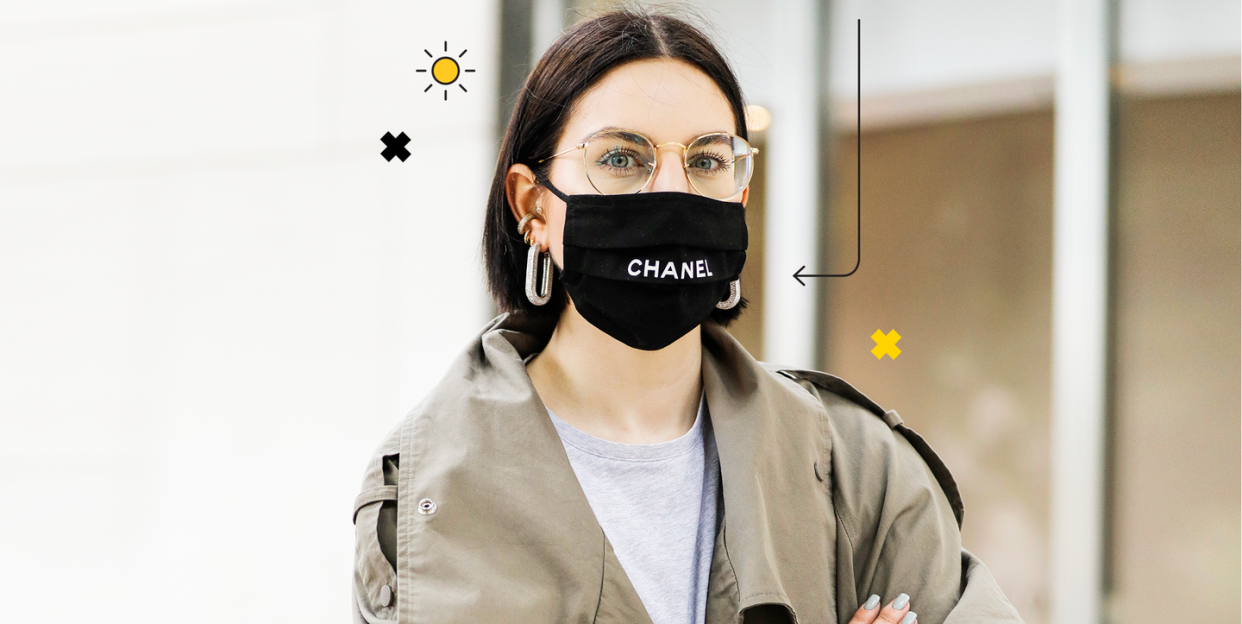*Siren* Your Cloth Face Mask Isn’t Actually Protecting You From the Sun

I have a confession: Until a few days ago, I fully thought I could skimp on my SPF because my cloth face mask (which I wear any and every time I leave the house, tyvm) covers the majority of my face. Like, my skin is behind multiple layers of fabric, so how could it be exposed to UV rays, right? Turns out, I was so, so wrong.
Recently, when I was chatting with dermatologist Orit Markowitz, MD, director of pigmented lesions and skin cancer at Mount Sinai in NYC, she suddenly dropped some knowledge on me: A typical cloth face mask gives you the equivalent sun protection of only SPF 7 or so. Umm, what?! Which means that to actually keep your skin safe from harmful and damaging effects of UV rays—and to keep your acne scars, dark spots, melasma, and hyperpigmentation from getting worse—you one hundred percent need to wear sunscreen under your face mask.
Why most cloth masks don’t protect your skin from UV rays
IDK about you, but now that the weather regularly resembles that of a steam room, I’m trying to wear the lightest, most breathable face masks I can find—and I’m guessing you are too. Normally, this is fine, but when it comes to protecting your skin from the sun? Not so much.
A post shared by Lizzo (@lizzobeeating) on May 23, 2020 at 9:58am PDT
The looser the weave of the fabric—aka how “breathable” it is—the worse it is at blocking UV rays, explains Dr. Markowitz. (I’m going to assume Kween Lizzo is wearing SPF 70 under that mask, obvs.) That means that a mask made of linen or cotton (the latter happens to be the fabric I’ve recommended to pretty much everyone over the past few months if you want to help mitigate maskne or skin irritation) is about the same as wearing SPF 7. Which, you know, is a problem, considering the American Academy of Dermatology recommends that everyone—regardless of skin tone—wear a minimum of SPF 30 every single day.
It’s worth noting that if your mask is a three-ply mask or made with a tightly woven synthetic fabric (like polyester or rayon), you’re probably getting a little more protection than SPF 7, but if the fabric stretches or gets wet (hi, sweaty skin), it decreases its ability to shield you from the sun—so you really can’t count on any SPF protection in the end. Womp, womp.
Another thing to consider? The color of your face mask. “In general, lighter-colored masks, like white or pastel, provide less UV protection than, say, a black or navy mask,” says Dr. Markowitz. So your lightweight white bandanna tied around your face during your afternoon run? Yeah, nah—not doing a thing for your skin protection.
The easy solution? Wearing SPF 30 or more under your go-to face mask—even on cloudy days or when you’re outside for just a few minutes (refresher: sun damage is cumulative, so every little bit of exposure adds up). And no, before you ask, your SPF-spiked makeup doesn’t count—you’ll never apply enough to get the full protection listed on the tube. I’m talking about regular good old sunscreen.
If you’re concerned about breakouts, I 10/10 recommend choosing a sunscreen that’s lightweight, oil-free, and/or noncomedogenic (like the ones above) to protect your skin without running the risk of clogged pores or acne. And this should go without saying, but I’ll remind you anyway: If you want to avoid maskne, you need to wash your face with a gentle cleanser to get rid of any sweat, excess oil, and buildup at the end of the day.
On days when you’re going to be spending a lot of time outside (like hanging in the park, chilling at the beach, or doing a socially distanced alfresco brunch), consider swapping your usual face mask for one made with a UPF (ultraviolet protection factor) fabric. “UPF masks are densely woven to help block UVA and UVB rays from penetrating the fabric and reaching your skin,” says Dr. Markowitz. Think of it as the SPF scale but for clothing—if a mask has a UPF factor of 50, it blocks 98 percent of UV rays. Pair a UPF mask (try one of the ones below) with SPF 30 or more, and your risk of sun burn, sun damage, and, more importantly, skin cancer, goes down.
The takeaway
If you want to adequately protect your skin from the sun AND be a good citizen and stop the spread of COVID-19 (I’m gonna go ahead and assume you eagerly said yes to both 🙃), then slathering SPF 3o or more all over your face and popping on a cloth face mask every single time you leave the house should be your new personal norm.
And one last thing: Don’t forget to reapply that SPF! (Remember, whatever protection you’re getting from your mask is negligible.) “To get the most out of your sunscreen, you want to reapply it every two hours or immediately after swimming or sweating,” says Dr. Markowitz. Got that? Cool.
You Might Also Like


